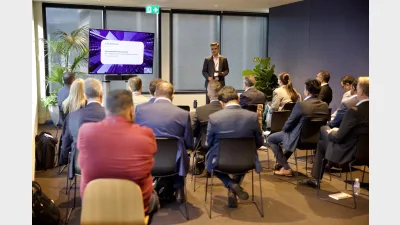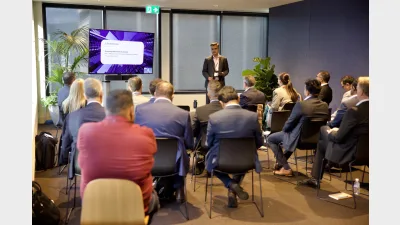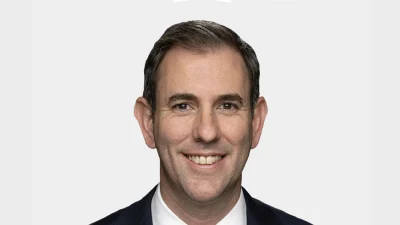Superannuation custodians look to step up service levels


Amid high levels of market turbulence, custodians are looking to deliver consistency to their superannuation fund clients with ever higher service levels.
Australian superannuation is in an interesting place at the moment. Though investment market turmoil continues to undermine account balances, positive legislative change, growing financial literacy and fierce competition in the super marketplace mean that in many ways, fund members have never been better served.
Of course, it isn’t just fund executives feeling that competitive pressure. Difficult financial times place pressure on all service providers but, according to Daryl Crich, head of product and strategy for BNP Paribas Securities Services, the unique challenge for custodians lies in providing surety.
“We’re in an interesting position at the moment, not just in superannuation but also within wider financial services,” said Crich. “But as a custodian, as the keepers of information, our focus is upon providing our clients with surety in times of difficulty.”
And in terms of standing out from the crowd, Crich said that being the custody arm of one of the world’s leading financial institutions allows BNP Paribas to give its clients a significant advantage.
“Being part of a global bank and being able to leverage its resources makes our offering very attractive to funds,” he said. “However, performance and analytic solutions such as our Investment and Performance Reporting (IRP) service are also good examples of the advantages that we can provide.
“The IRP service is very powerful for delivering information back to funds,” Crich added. “Information on investments, right the way through to compliance and risk management.
“For us, the overarching theme is information and the tools through which that can be provided.”
Interestingly, Richard Coia, head of master custody for National Australia Bank custodian services (NCS), said that while product development would always be a point of differentiation, custodians needed to ensure they had core custody in place.
“Core custody services are fundamental,” he said. “They are integral to the operating model, linking the administrator, the client, the trustee — all parties in the super transaction.
“At NAB Custodian Services, we’ve done a lot of work on report delivery,” Coia continued. “That is, unit pricing reporting, online reporting and the flexibility and availability of those services that are the direct line feed into a client’s administration offices.”
However, like Crich, Coia said that development of value-added services ensured that the custody offering remained attractive.
“Product development, propagation, tax optimisation and our foreign exchange service are all points of differentiation, but Master Manager probably provides the best example,” he said.
“Master Manager gives clients the ability to conduct net trades at the broker level,” said Coia. “Being able to cross different fund managers within the same portfolio and identify net trades, they can defer capital gains tax and reduce brokerage costs.
“Those are savings that add up.”
On the other hand, David McWilliams, head of sales and business development for ANZ Custodian Services, said that custody remained a people-driven business.
“Clients want their custodian to be proactive and ahead of the servicing curve and they want their account managers ‘available’,” he said. “In challenging times like the market conditions that we are currently experiencing, it is important to ensure all the basic tenets of clients’ service and relationship management are respected.
“Of course, margin compression is evident all around, but you have to play to your strengths and promote these accordingly.”
McWilliams said ANZ aimed to stand out from the crowd by offering clients broader financial services expertise.
“At ANZ we have a dedicated financial institutions team whose focus is on understanding all the participant links that make up the servicing of a super provider,” he said.
“We can then bring all of ANZ’s expertise, not just in custody, but other areas such as cash management, markets and [foreign exchange] for example, to offer an integrated solution for our clients.”
Yet increases and improvements in service provider offerings have not been the only consequences of a newly competitive super marketplace. Consolidation, particularly within the highly specialised custody field, has been a reality for some time now.
But McWilliams believes the market has reached a balance point.
“I do believe we have reached a balance point in terms of consolidation,” he said. “ANZ and NAB are the only two remaining ‘local’ custodians.
“And among some clients, there is an opinion that there is not enough custody alternatives,” McWilliams continued. “This view is particularly evident among the small to medium fund clients.
“Yes, the bigger globals have arrived and there may still be more to come, but I would consider that we probably have the maximum number for the opportunities available at this point in time.”
Crich said that if he had been asked the consolidation question two years ago, his answer would have been that it was certainly a trend set to continue.
“But at the moment, you can’t discount global players coming in,” he said.
Crich added that globalisation in and of itself had also had an interesting effect on the custody space.
“Obviously, the amount of capital flowing offshore from super funds is increasing,” he said. “Asian markets are becoming more and more viable and there is movement in New Zealand as well.
“As the fourth largest fund market in the world, Australia is an attractive prospect and global players are well-placed to take advantage of these sorts of global opportunities.”
However, global or local, the challenges for custody providers to Australia’s superannuation industry remain the same. Meeting client expectations mean they must look to relationships and they must look to needs alignment.
But where does the line lie between specialising according to the custodian’s strengths and moving to a broader-based offering?
For McWilliams, that question — whether the custodian should try to offer the complete ‘one-stop product shop’ — is the perennial strategic issue.
“Whilst ANZ Custodian Services offers clients a comprehensive product suite, and we have most of the ticks in the required boxes, we are also cognisant of playing to our strengths,” said McWilliams.
“That strength is our core competency in domestic and sub custody.
“Aligning your product suite with your client’s needs is an obvious business objective,” McWilliams continued. “But any in-house product development objective needs to be evaluated and balanced against any potential outsourcing opportunities.”
Yet whether you are talking about custody provision to super funds or custody provided to fund managers, investment funds and other platforms, Crich said that there remained a degree of core offering that custodians had to be on top of.
“Custody is a broad term nowadays,” he said. “But, typically, master custody includes core custody, transactions, accounting services, unit pricing, tax reporting, etcetera.
“The supplementary services are analytics, post-trade compliance and so on,” Crich continued. “But before they are offered, there has to be a need for those services.
“At the moment, the key requirement within super custody is to answer drives for scale and drives for increased reporting. To do that we must constantly deliver our core service in an improving marketplace.”
Alternatively, Coia stated that for NCS, there had never been a need for market dissection.
“Most of our competitors specialise,” he said. “But NCS is across master custody, sub custody and through to back-office administration.”
Coia added that bridging the gap between investment custody and super custody was simply about morphing the service.
“The operating model, how it works for settlement and how it works for reporting all turn into the daily environment,” he said. “Certainly, there are differences in what is offered, but it is still custody, it is still reporting, foreign exchange and securities lending.
“Fundamentally, the differences are only apparent in the reporting segment.”
McWilliams said that the same internal processing technology was used to service the bulk of any investor’s regular investments.
“What the large super funds brought to the table a long time ago was the specialised requirement for ‘full service’ master custody, which is not necessarily required for other client profiles,” he said. “This required innovation and specialisation from the custodian where multiple fund managers and investing offshore was required.”
McWilliams added that super funds had also been at the forefront of driving specialisation in processing techniques as their security investment profile had become more sophisticated.
“Private equity, direct property and infrastructure type assets require specialised processing, often involving considerable legal, compliance and operational complexity,” he said.
“If a super fund has 20 per cent exposure to alternative assets, or any exposure for that matter, then the custodian has to make the commercial and relationship sensitive decision as to whether they will take contractual responsibility for servicing this piece.
“The alternative is declining and facing the consequences.”
Of course, the legal, compliance and operational complexities referred to by McWilliams have other ramifications for custodians.
The modern reality of the business world and of the financial services industry is that corporate governance, transparency and risk management are very real concerns.
And with super funds acutely aware of the security of both their members’ assets and their own reputation, Crich said it continued to be an integral part of custody.
“Risk management and governance are paramount within the custody service,” he said. “And the industry’s recent adoption of Anti-Money Laundering and Counter-Terrorism (AMLCT) legislation is a good example of that. We were probably 90 per cent compliant before it was even legislated.
“We do a great deal of due diligence on our reporting framework and our internal control environment,” Crich continued. “And as keepers of the wallet, so to speak, that kind of attention is vital for custodians.”
For his part, Coia said that he had seen the custody business totally transform around setting up the right risk management framework.
“As an example, NCS has its own legal counsel that is dedicated to the custody business,” he said. “We have disaster recovery plans [and] a policy group looking at legislative and regulatory change as it comes up, all ensuring that our service is both satisfactory and compliant.
“Operational risk, people risk, credit risk and compliance,” he listed. “They are all absolutely fundamental in this business and form a significant part of what we do.”
But if sound risk management provides super funds with safeguards against complexity, then technology allows custodians to achieve the necessary processing grunt.
Crich said that technology had to be a top priority for custodians.
“There’s simply no way around that,” he said. “And I shudder to think how this kind of work was done before today’s systems were in place.
“It’s essential that we have high levels of straight-through-processing and integrated architecture within our service because it would be almost impossible to deliver without it.”
Crich added that the source of technology solutions was also important because BNP Paribas Securities Services did not wish to become a software vendor in addition to being a custodian.
“Our focus is on buying before building, but we will build where additional value is possible,” he said.
McWilliams said that he too saw technology continuing to be a critical part of custody provision.
“Technology is obviously critical because it gives you processing scale,” he said.
“In Australia, our rules and regulations never stand still,” McWilliams continued. “And in terms of product evolution, the same holds true for the marketplace more generally.
“There is a continual need to invest in technology to adapt for these changes because those that don’t strive for an environment of continuous IT improvement will get left behind.”
So what’s next for superannuation service provision and custody in particular?
Though consolidation within the custody space seems to be on hold for the moment, its impact seems set to continue within the wider industry. So with at least some administrators to the super industry already providing their clients with both administration and technology in one package, are we seeing the beginning of a trend?
Could custodians provide the lead?
For Crich, it is an interesting question.
“I suppose it goes back to how far a ‘one-stop shop’ should have to go?” he said.
Crich pointed out that under normal circumstances, super administration would be kept separate from custody provision and from the fund itself.
“So I don’t think that a natural consolidation of those is an obvious call,” he added.
“To do so, you would be mixing skill sets that aren’t necessarily complementary,” Crich continued. “And that would need to be handled very carefully indeed.
“Though there are some synergies between the services, I certainly can’t see it being a natural progression.”
McWilliams said that the concept of consolidated technology, administration and custody services went back to his earlier comments on whether custodians chose to be all things to all people.
“There is no ultimate reason why technology, administration and custody cannot be packaged,” he said.
“But going [down] this route is about ensuring that your capabilities and expertise in one area are not degraded or diminished at the expense of your other product.”
However, putting the possibility of long-term service consolidation aside, McWilliams said that custodians’ short-term challenge lay in keeping their services at high levels despite the market downturn.
“Obviously, a downturn in markets impacts all market participants,” he said. “Yet despite that, we’ve found that trading volumes have remained constant on the back of what I suspect are clients rebalancing their portfolios.”
Crich agreed that difficult financial times place more pressure on everyone.
“We are already seeing an increased focus on investment performance as the traditional investments fail to perform,” he said. “And as members see those losses, there is the potential that it will force funds to consider non-traditional alternatives.
“But if that is the case, then as keepers of information, we are well placed to help with that change,” Crich said.
McWilliams advised custodians to be mindful of their priorities.
“We know we cannot control the markets,” he said. “However, what we can control in these challenging times is our level of client and customer service.
“Keeping these at the highest standards remains our number one priority.”
Recommended for you
Australia’s $4 trillion superannuation industry is at a critical digital crossroads, with outdated systems threatening funds’ ability to keep up with rising member expectations and increasing regulatory demands.
Data from Chant West reinforced on Friday that super funds finished April in positive territory despite ‘Liberation Day’-driven market turmoil.
Australia’s superannuation leaders gathered in Melbourne on Thursday for a closed-door forum tackling the escalating impact of artificial intelligence and shifting retirement income models on the sector.
The Treasurer has shown no signs of wavering on the construction of the controversial tax, while Liberal senator Jane Hume has urged the new economics team to “speak sense” to Jim Chalmers.













